Search results for: 'Fiber c'
- Related search terms
- fiber
- Fiber ca
- Fiber machine
- Fiber machi
- fiber b
-
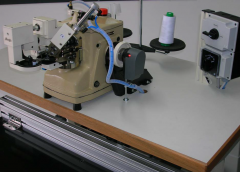 M-1004 SPECIAL SEWING MACHINE FOR CLOSING PILLOWS AND CUSHIONSFOR CLOSING PILLOWS AND CUSHIONS (IN FEATHER, BALL FIBER, RECYCLED FIBER AND SIMILAR) THIS MACHINE IS SPECIFIC FOR THE CLOSING OF ROLOFIL CUSHIONS, FEATHER PILLOWS, CARDED CUSHIONS, CUSHIONS WITH FOAM AND SYNTHETIC FIBRES, ALL KIND OF CUSHIONS, EVEN BIG SHAPED SIZES. THE RANGE OF SEWING MACHINE HAS BEEN STUDIED AND BUILT FOLLOWING THE MOST MODERN CONCEPT OF TECHNOLOGY; THEIR COMPONENTS ARE THE MOST ADVANCED AND THE MATERIALS ARE HIGHLY SELECTED: THIS MAKES THE MACHINES STRONG, SAFE, SILENT AND EASY TO BE USED. OPERATIONS FEATURES: THE SPECIAL PLATES (BOTH MOTORIZED) AND THE EXTENDED SEWING BLOCK HELP THE OPERATOR IN THE SEWING OF ANY KIND OF SHAPED CUSHIONS AND DIFFERENT MATERIALS. WITH THE DOUBLE CONVEYING SYSTEM THE MATERIAL IS CONVEYING REGULARLY AND THIS GIVES AN HIGH QUALITY TO THE SEAM AND TO THE PRODUCE, ESPECIALLY WHEN THE PRODUCT IS A “REMOVABLE COVER” SOFA, AND NOT ONLY. VERSATILITY AND PERFORMANCE: KITS AND ACCESSORIES ARE AVAILABLE TO MEET THE MOST DIFFERENT REQUIREMENTS. IT IS POSSIBLE TO SEW (NEVER MIND THE SIZE, THE SHAPE AND THE WEIGHT): - LIGHT COTTON, NONWOVEN, FABRICS COUPLED WITH SYNTHETIC FIBRES, POLYESTER, CARDED AND SIMILAR. - FEATHER PILLOWS - HEAVY MATERIAL SUCH AS CUSHIONS IN SYNTHETIC FIBRES OR DACRON COUPLED WITH FOAM, CUSHIONS WITH SPRINGS ETC. COMPLETE WITH: - EXTENDED SEWING GROUP WITH DOUBLE MOTORIZED TOOTHED PLATES. - SEWING HEAD (OVERLOCK – 1 YARN) STITCH LENGTH: 1 TO 5mm - YARN CUTTING (TRIMMER), CUPS OPENING AND PNEUMATIC OIL PUMP - ELECTRONIC EFKA MOTOR 220V/240V SINGLE PHASE - SPEED: 1900 RPM - PERFORMANCE: 6 SECONDS PER CUSHION (SEWING 15 TO 20 CENTIMETERS) - ELECTRONIC MOBILE FOOTBOARD ALSO INCLUDES 1 SET OF NEEDLES, 1 INSTRUCTION BOOK, 1 CE CONFORMITYPRODUCTIVITY: 10/12 CUSHIONS PER MINUTE (CONSIDERED A OPEN SIDE OF 6/8”) Learn More
M-1004 SPECIAL SEWING MACHINE FOR CLOSING PILLOWS AND CUSHIONSFOR CLOSING PILLOWS AND CUSHIONS (IN FEATHER, BALL FIBER, RECYCLED FIBER AND SIMILAR) THIS MACHINE IS SPECIFIC FOR THE CLOSING OF ROLOFIL CUSHIONS, FEATHER PILLOWS, CARDED CUSHIONS, CUSHIONS WITH FOAM AND SYNTHETIC FIBRES, ALL KIND OF CUSHIONS, EVEN BIG SHAPED SIZES. THE RANGE OF SEWING MACHINE HAS BEEN STUDIED AND BUILT FOLLOWING THE MOST MODERN CONCEPT OF TECHNOLOGY; THEIR COMPONENTS ARE THE MOST ADVANCED AND THE MATERIALS ARE HIGHLY SELECTED: THIS MAKES THE MACHINES STRONG, SAFE, SILENT AND EASY TO BE USED. OPERATIONS FEATURES: THE SPECIAL PLATES (BOTH MOTORIZED) AND THE EXTENDED SEWING BLOCK HELP THE OPERATOR IN THE SEWING OF ANY KIND OF SHAPED CUSHIONS AND DIFFERENT MATERIALS. WITH THE DOUBLE CONVEYING SYSTEM THE MATERIAL IS CONVEYING REGULARLY AND THIS GIVES AN HIGH QUALITY TO THE SEAM AND TO THE PRODUCE, ESPECIALLY WHEN THE PRODUCT IS A “REMOVABLE COVER” SOFA, AND NOT ONLY. VERSATILITY AND PERFORMANCE: KITS AND ACCESSORIES ARE AVAILABLE TO MEET THE MOST DIFFERENT REQUIREMENTS. IT IS POSSIBLE TO SEW (NEVER MIND THE SIZE, THE SHAPE AND THE WEIGHT): - LIGHT COTTON, NONWOVEN, FABRICS COUPLED WITH SYNTHETIC FIBRES, POLYESTER, CARDED AND SIMILAR. - FEATHER PILLOWS - HEAVY MATERIAL SUCH AS CUSHIONS IN SYNTHETIC FIBRES OR DACRON COUPLED WITH FOAM, CUSHIONS WITH SPRINGS ETC. COMPLETE WITH: - EXTENDED SEWING GROUP WITH DOUBLE MOTORIZED TOOTHED PLATES. - SEWING HEAD (OVERLOCK – 1 YARN) STITCH LENGTH: 1 TO 5mm - YARN CUTTING (TRIMMER), CUPS OPENING AND PNEUMATIC OIL PUMP - ELECTRONIC EFKA MOTOR 220V/240V SINGLE PHASE - SPEED: 1900 RPM - PERFORMANCE: 6 SECONDS PER CUSHION (SEWING 15 TO 20 CENTIMETERS) - ELECTRONIC MOBILE FOOTBOARD ALSO INCLUDES 1 SET OF NEEDLES, 1 INSTRUCTION BOOK, 1 CE CONFORMITYPRODUCTIVITY: 10/12 CUSHIONS PER MINUTE (CONSIDERED A OPEN SIDE OF 6/8”) Learn More -
 M-4432 SCHLAFHORST 338 WINDER YEAR 2001-2002 – 60 POSITIONS / 50 POSITIONSREFERENCE NUMBER: M-4432 (1010MNJWHH9) K SCHLAFHORST 338 WINDER YEAR 2001-2002 – 60 POSITIONS / 50 POSITIONS 2 SETS OF SCHALFHORST’S 338 WINDER A. 1 SET X 60 DRUMS MODEL : 338 (R SIDE) YEAR : 2001 NO. OF SPINDLE : 60 FEEDING : MAGAZINE MAGAZINE POCKET : 6 DRUM : STEEL MADE, 2.0 TURN, 6” TRAVERSE TAKE-UP SHAPE : 5°57 YARN CLEARER : USTER QUANTUM 1 (NO FOREIGN FIBER DETECTOR) SPLICER : PRISM DZ3 SUCTION TAIL END WITH OVERHEAD CLEANER WITHOUT WAXING DEVICE INDIVIDUAL SUCTION BLOWER (UPWARD) WITHOUT AUTO-DOFFER WITHOUT PACKAGE CONVEYOR POWER “ 380V50HZ B. 1 SET X 50 DRUMS MODEL : 338 (L SIDE) YEAR 2002 NO. OF SPINDLE : 50 FEEDING : MAGAZINE MAGAZINE POCKET : 6 DRUM : STEEL MADE, 2.5 TURN, 6” TRAVERSE TAKE-UP SHAPE : 5°57 YARN CLEARER : USTER QUANTUM 2 (NO FOREIGN FIBER DETECTOR) SPLICER : PRISM DZ3 SUCTION TAIL END WITH OVERHEAD CLEANER WITH WAXING DEVICE INDIVIDUAL SUCTION BLOWER (UPWARD) WITHOUT AUTO-DOFFER WITHOUT PACKAGE CONVEYOR POWER “ 380V50HZ QUANTITY AVAILABLE: 2 Learn More
M-4432 SCHLAFHORST 338 WINDER YEAR 2001-2002 – 60 POSITIONS / 50 POSITIONSREFERENCE NUMBER: M-4432 (1010MNJWHH9) K SCHLAFHORST 338 WINDER YEAR 2001-2002 – 60 POSITIONS / 50 POSITIONS 2 SETS OF SCHALFHORST’S 338 WINDER A. 1 SET X 60 DRUMS MODEL : 338 (R SIDE) YEAR : 2001 NO. OF SPINDLE : 60 FEEDING : MAGAZINE MAGAZINE POCKET : 6 DRUM : STEEL MADE, 2.0 TURN, 6” TRAVERSE TAKE-UP SHAPE : 5°57 YARN CLEARER : USTER QUANTUM 1 (NO FOREIGN FIBER DETECTOR) SPLICER : PRISM DZ3 SUCTION TAIL END WITH OVERHEAD CLEANER WITHOUT WAXING DEVICE INDIVIDUAL SUCTION BLOWER (UPWARD) WITHOUT AUTO-DOFFER WITHOUT PACKAGE CONVEYOR POWER “ 380V50HZ B. 1 SET X 50 DRUMS MODEL : 338 (L SIDE) YEAR 2002 NO. OF SPINDLE : 50 FEEDING : MAGAZINE MAGAZINE POCKET : 6 DRUM : STEEL MADE, 2.5 TURN, 6” TRAVERSE TAKE-UP SHAPE : 5°57 YARN CLEARER : USTER QUANTUM 2 (NO FOREIGN FIBER DETECTOR) SPLICER : PRISM DZ3 SUCTION TAIL END WITH OVERHEAD CLEANER WITH WAXING DEVICE INDIVIDUAL SUCTION BLOWER (UPWARD) WITHOUT AUTO-DOFFER WITHOUT PACKAGE CONVEYOR POWER “ 380V50HZ QUANTITY AVAILABLE: 2 Learn More -
 TT-7646 USTER AFIS PRO, YEAR 2004TT-7646 USTER AFIS PRO, YEAR 2004 QUANTITY: 1 Learn More
TT-7646 USTER AFIS PRO, YEAR 2004TT-7646 USTER AFIS PRO, YEAR 2004 QUANTITY: 1 Learn More -
 TT-7553 MURATA MVS III 870 JET SPINNING MACHINE, 96 SPINDLES, YEAR 2016 TO 2017TT-7553 MURATA MVS III 870 JET SPINNING MACHINE, 96 SPINDLES, YEAR 2016 TO 2017 QUANTITY: 5 SETS Learn More
TT-7553 MURATA MVS III 870 JET SPINNING MACHINE, 96 SPINDLES, YEAR 2016 TO 2017TT-7553 MURATA MVS III 870 JET SPINNING MACHINE, 96 SPINDLES, YEAR 2016 TO 2017 QUANTITY: 5 SETS Learn More -
 TT-6910 FIBER (STOCK) DYE PLANT, WORKING WIDTH 1500mm, YEAR 1985 TO 2007TT-6910 FIBER (STOCK) DYE PLANT, WORKING WIDTH 1500mm, YEAR 1985 TO 2007 1. FIBER (STOCK) DYE PLANT 2. YEAR 1985 TO 2007 QUANTITY: 1 Learn More
TT-6910 FIBER (STOCK) DYE PLANT, WORKING WIDTH 1500mm, YEAR 1985 TO 2007TT-6910 FIBER (STOCK) DYE PLANT, WORKING WIDTH 1500mm, YEAR 1985 TO 2007 1. FIBER (STOCK) DYE PLANT 2. YEAR 1985 TO 2007 QUANTITY: 1 Learn More -
 TT-5253 FIBER BLOWING SYSTEM FOR PILLOWSTT-5253 FIBER BLOWING SYSTEM FOR PILLOWS QUANTITY: 1 Learn More
TT-5253 FIBER BLOWING SYSTEM FOR PILLOWSTT-5253 FIBER BLOWING SYSTEM FOR PILLOWS QUANTITY: 1 Learn More -
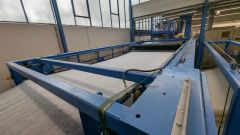 TT-4359 NEEDLE PUNCHING LINE, YEAR 1993 TO 2023TT-4359 NEEDLE PUNCHING LINE, YEAR 1993 TO 2023 CARDING + LAPPING + DILO NEEDLE LOOM OUG II-S40 BRAND: TRUTZSCHLER, REISKY & SCHLESE, DILO, MESUTRONIC, TEMAFA FIBER: SYNTHETIC & VISCOS FIBER FINENESS: 1.7 TO 6.7 DTEX Learn More
TT-4359 NEEDLE PUNCHING LINE, YEAR 1993 TO 2023TT-4359 NEEDLE PUNCHING LINE, YEAR 1993 TO 2023 CARDING + LAPPING + DILO NEEDLE LOOM OUG II-S40 BRAND: TRUTZSCHLER, REISKY & SCHLESE, DILO, MESUTRONIC, TEMAFA FIBER: SYNTHETIC & VISCOS FIBER FINENESS: 1.7 TO 6.7 DTEX Learn More -
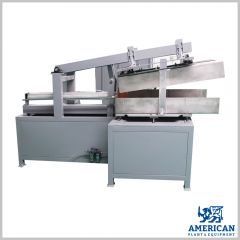 J-3929-B FOAM CUSHION FILLING MACHINE, LENGTH 600 TO 1000mm (23.5” TO 39.5”)J-3929-B FOAM CUSHION FILLING MACHINE, LENGTH 600 TO 1000mm (23.5” TO 39.5”) CAPACITY: 2 TO 3 PIECES PER MINUTE (120 TO 180 PIECES PER HOUR), DEPENDING ON THE MATERIALS OF THE CUSHION AND DEPENDING ON THE OPERATOR LENGTH: 600 TO 1000mm (23.5” TO 39.5”) QUANTITY: 1 Learn More
J-3929-B FOAM CUSHION FILLING MACHINE, LENGTH 600 TO 1000mm (23.5” TO 39.5”)J-3929-B FOAM CUSHION FILLING MACHINE, LENGTH 600 TO 1000mm (23.5” TO 39.5”) CAPACITY: 2 TO 3 PIECES PER MINUTE (120 TO 180 PIECES PER HOUR), DEPENDING ON THE MATERIALS OF THE CUSHION AND DEPENDING ON THE OPERATOR LENGTH: 600 TO 1000mm (23.5” TO 39.5”) QUANTITY: 1 Learn More -
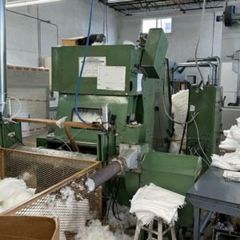 TT-2986 WISE INDUSTRIES INC FIBER BLOWING UNIT, EXTENDED APRON OF 72”TT-2986 WISE INDUSTRIES INC FIBER BLOWING UNIT, EXTENDED APRON OF 72” QUANTITY: 1 Learn More
TT-2986 WISE INDUSTRIES INC FIBER BLOWING UNIT, EXTENDED APRON OF 72”TT-2986 WISE INDUSTRIES INC FIBER BLOWING UNIT, EXTENDED APRON OF 72” QUANTITY: 1 Learn More -
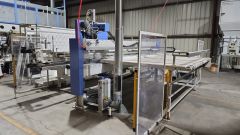 J-4898 MAMMUT QUILTING LINE – 90 INCHES WIDE (2300mm) FROM OPENING THROUGH QUILTING, INCLUDING PANEL SIDE SEWING AND CROSS CUTTINGJ-4898 MAMMUT QUILTING LINE – 90 INCHES WIDE (2300mm) FROM OPENING THROUGH QUILTING, INCLUDING PANEL SIDE SEWING AND CROSS CUTTING COMPOSED OF: FIBER HOPPER LINE – BLENDING LINE NOWO FIBER OPENER MASIAS CHUTE FEED SYSTEM MAMMUT QUILTING MACHINE 3 BAR CHAIN 90 INCH (2300mm) HAUSER IN-LINE PANEL CUTTING MACHINE QUANTITY: 1 Learn More
J-4898 MAMMUT QUILTING LINE – 90 INCHES WIDE (2300mm) FROM OPENING THROUGH QUILTING, INCLUDING PANEL SIDE SEWING AND CROSS CUTTINGJ-4898 MAMMUT QUILTING LINE – 90 INCHES WIDE (2300mm) FROM OPENING THROUGH QUILTING, INCLUDING PANEL SIDE SEWING AND CROSS CUTTING COMPOSED OF: FIBER HOPPER LINE – BLENDING LINE NOWO FIBER OPENER MASIAS CHUTE FEED SYSTEM MAMMUT QUILTING MACHINE 3 BAR CHAIN 90 INCH (2300mm) HAUSER IN-LINE PANEL CUTTING MACHINE QUANTITY: 1 Learn More
